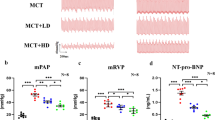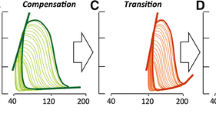Abstract
Right ventricular hypertrophy (RVH) and RV failure contribute to morbidity and mortality in pulmonary arterial hypertension (PAH). The cause of RV dysfunction and the feasibility of therapeutically targeting the RV are uncertain. We hypothesized that RV dysfunction and electrical remodeling in RVH result, in part, from a glycolytic shift in the myocyte, caused by activation of pyruvate dehydrogenase kinase (PDK). We studied two complementary rat models: RVH + PAH (induced by monocrotaline) and RVH + without PAH (induced by pulmonary artery banding (PAB)). Monocrotaline RVH reduced RV O2-consumption and enhanced glycolysis. RV 2-fluoro-2-deoxy-glucose uptake, Glut-1 expression, and pyruvate dehydrogenase phosphorylation increased in monocrotaline RVH. The RV monophasic action potential duration and QTc interval were prolonged due to decreased expression of repolarizing voltage-gated K+ channels (Kv1.5, Kv4.2). In the RV working heart model, the PDK inhibitor, dichloroacetate, acutely increased glucose oxidation and cardiac work in monocrotaline RVH. Chronic dichloroacetate therapy improved RV repolarization and RV function in vivo and in the RV Langendorff model. In PAB-induced RVH, a similar reduction in cardiac output and glycolytic shift occurred and it too improved with dichloroacetate. In PAB-RVH, the benefit of dichloroacetate on cardiac output was approximately 1/3 that in monocrotaline RVH. The larger effects in monocrotaline RVH likely reflect dichloroacetate’s dual metabolic benefits in that model: regression of vascular disease and direct effects on the RV. Reduction in RV function and electrical remodeling in two models of RVH relevant to human disease (PAH and pulmonic stenosis) result, in part, from a PDK-mediated glycolytic shift in the RV. PDK inhibition partially restores RV function and regresses RVH by restoring RV repolarization and enhancing glucose oxidation. Recognition that a PDK-mediated metabolic shift contributes to contractile and ionic dysfunction in RVH offers insight into the pathophysiology and treatment of RVH.








Similar content being viewed by others
References
Bonnet S, Michelakis ED, Porter CJ, Andrade-Navarro MA, Thebaud B, Haromy A, Harry G, Moudgil R, McMurtry MS, Weir EK, Archer SL (2006) An abnormal mitochondrial-hypoxia inducible factor-1alpha-Kv channel pathway disrupts oxygen sensing and triggers pulmonary arterial hypertension in fawn hooded rats: similarities to human pulmonary arterial hypertension. Circulation 113:2630–2641
van Wolferen SA, Marcus JT, Boonstra A, Marques KM, Bronzwaer JG, Spreeuwenberg MD, Postmus PE, Vonk-Noordegraaf A (2007) Prognostic value of right ventricular mass, volume, and function in idiopathic pulmonary arterial hypertension. Eur Heart J 28:1250–1257
Hessel MH, Steendijk P, den Adel B, Schutte CI, van der Laarse A (2006) Characterization of right ventricular function after monocrotaline-induced pulmonary hypertension in the intact rat. Am J Physiol Heart Circ Physiol 291:H2424–H2430
Lamberts RR, Caldenhoven E, Lansink M, Witte G, Vaessen RJ, St Cyr JA, Stienen GJ (2007) Preservation of diastolic function in monocrotaline-induced right ventricular hypertrophy in rats. Am J Physiol Heart Circ Physiol 293:H1869–H1876
Lee JK, Kodama I, Honjo H, Anno T, Kamiya K, Toyama J (1997) Stage-dependent changes in membrane currents in rats with monocrotaline-induced right ventricular hypertrophy. Am J Physiol 272:H2833–H2842
Lee JK, Nishiyama A, Kambe F, Seo H, Takeuchi S, Kamiya K, Kodama I, Toyama J (1999) Downregulation of voltage-gated K(+) channels in rat heart with right ventricular hypertrophy. Am J Physiol 277:H1725–H1731
Zhang TT, Cui B, Dai DZ (2004) Downregulation of Kv4.2 and Kv4.3 channel gene expression in right ventricular hypertrophy induced by monocrotaline in rat. Acta Pharmacol Sin 25:226–230
Hlaing T, Guo D, Zhao X, DiMino T, Greenspon L, Kowey PR, Yan GX (2005) The QT and Tp-e intervals in left and right chest leads: comparison between patients with systemic and pulmonary hypertension. J Electrocardiol 38:154–158
De Ambroggi L, Francia P, De Ambroggi G (2007) Repolarization abnormalities and arrhythmogenesis in hypertrophic myocardium. Anadolu Kardiyol Derg 7(Suppl 1):71–72
Kaprielian R, Wickenden AD, Kassiri Z, Parker TG, Liu PP, Backx PH (1999) Relationship between K + channel down-regulation and [Ca2+]i in rat ventricular myocytes following myocardial infarction. J Physiol 517(Pt 1):229–245
Wood EH (2000) Action potential control of cardiac contractility. Ann Biomed Eng 28:860–870
Harris DM, Mills GD, Chen X, Kubo H, Berretta RM, Votaw VS, Santana LF, Houser SR (2005) Alterations in early action potential repolarization causes localized failure of sarcoplasmic reticulum Ca2+ release. Circ Res 96:543–550
Oikawa M, Kagaya Y, Otani H, Sakuma M, Demachi J, Suzuki J, Takahashi T, Nawata J, Ido T, Watanabe J, Shirato K (2005) Increased [18F]fluorodeoxyglucose accumulation in right ventricular free wall in patients with pulmonary hypertension and the effect of epoprostenol. J Am Coll Cardiol 45:1849–1855
Basu S, Alzeair S, Li G, Dadparvar S, Alavi A (2007) Etiopathologies associated with intercostal muscle hypermetabolism and prominent right ventricle visualization on 2-deoxy-2[F-18]fluoro-D-glucose-positron emission tomography: significance of an incidental finding and in the setting of a known pulmonary disease. Mol Imaging Biol 9:333–339
Hill NS, Jederlinic P, Gagnon J (1989) Supplemental oxygen reduces right ventricular hypertrophy in monocrotaline-injected rats. J Appl Physiol 66:1642–1648
Xu W, Koeck T, Lara AR, Neumann D, DiFilippo FP, Koo M, Janocha AJ, Masri FA, Arroliga AC, Jennings C, Dweik RA, Tuder RM, Stuehr DJ, Erzurum SC (2007) Alterations of cellular bioenergetics in pulmonary artery endothelial cells. Proc Natl Acad Sci U S A 104:1342–1347
Knoechel TR, Tucker AD, Robinson CM, Phillips C, Taylor W, Bungay PJ, Kasten SA, Roche TE, Brown DG (2006) Regulatory roles of the N-terminal domain based on crystal structures of human pyruvate dehydrogenase kinase 2 containing physiological and synthetic ligands. Biochemistry 45:402–415
Michelakis ED, McMurtry MS, Wu XC, Dyck JR, Moudgil R, Hopkins TA, Lopaschuk GD, Puttagunta L, Waite R, Archer SL (2002) Dichloroacetate, a metabolic modulator, prevents and reverses chronic hypoxic pulmonary hypertension in rats: role of increased expression and activity of voltage-gated potassium channels. Circulation 105:244–250
Bonnet S, Archer SL, Allalunis-Turner J, Haromy A, Beaulieu C, Thompson R, Lee CT, Lopaschuk GD, Puttagunta L, Harry G, Hashimoto K, Porter CJ, Andrade MA, Thebaud B, Michelakis ED (2007) A mitochondria-K + channel axis is suppressed in cancer and its normalization promotes apoptosis and inhibits cancer growth. Cancer Cell 11:37–51
Allard MF, Schonekess BO, Henning SL, English DR, Lopaschuk GD (1994) Contribution of oxidative metabolism and glycolysis to ATP production in hypertrophied hearts. Am J Physiol 267:H742–H750
Wambolt RB, Lopaschuk GD, Brownsey RW, Allard MF (2000) Dichloroacetate improves postischemic function of hypertrophied rat hearts. J Am Coll Cardiol 36:1378–1385
Rozanski GJ, Xu Z, Zhang K, Patel KP (1998) Altered K + current of ventricular myocytes in rats with chronic myocardial infarction. Am J Physiol 274:H259–H265
Knollmann BC, Katchman AN, Franz MR (2001) Monophasic action potential recordings from intact mouse heart: validation, regional heterogeneity, and relation to refractoriness. J Cardiovasc Electrophysiol 12:1286–1294
Liu B, Clanachan AS, Schulz R, Lopaschuk GD (1996) Cardiac efficiency is improved after ischemia by altering both the source and fate of protons. Circ Res 79:940–948
Barr RL, Lopaschuk GD (2000) Methodology for measuring in vitro/ex vivo cardiac energy metabolism. J Pharmacol Toxicol Methods 43:141–152
Abel ED (2004) Glucose transport in the heart. Front Biosci 9:201–215
Sharma S, Taegtmeyer H, Adrogue J, Razeghi P, Sen S, Ngumbela K, Essop MF (2004) Dynamic changes of gene expression in hypoxia-induced right ventricular hypertrophy. Am J Physiol Heart Circ Physiol 286:H1185–H1192
Kleiman RB, Houser SR (1989) Outward currents in normal and hypertrophied feline ventricular myocytes. Am J Physiol 256:H1450–H1461
Nagendran J, Gurtu V, Fu DZ, Dyck JR, Haromy A, Ross DB, Rebeyka IM, Michelakis ED (2008) A dynamic and chamber-specific mitochondrial remodeling in right ventricular hypertrophy can be therapeutically targeted. J Thorac Cardiovasc Surg 136:168–178 178 e161-163
Sugden MC, Langdown ML, Harris RA, Holness MJ (2000) Expression and regulation of pyruvate dehydrogenase kinase isoforms in the developing rat heart and in adulthood: role of thyroid hormone status and lipid supply. Biochem J 352(Pt 3):731–738
Clarke B, Wyatt KM, McCormack JG (1996) Ranolazine increases active pyruvate dehydrogenase in perfused normoxic rat hearts: evidence for an indirect mechanism. J Mol Cell Cardiol 28:341–350
Schott P, Singer SS, Kogler H, Neddermeier D, Leineweber K, Brodde OE, Regitz-Zagrosek V, Schmidt B, Dihazi H, Hasenfuss G (2005) Pressure overload and neurohumoral activation differentially affect the myocardial proteome. Proteomics 5:1372–1381
Lydell CP, Chan A, Wambolt RB, Sambandam N, Parsons H, Bondy GP, Rodrigues B, Popov KM, Harris RA, Brownsey RW, Allard MF (2002) Pyruvate dehydrogenase and the regulation of glucose oxidation in hypertrophied rat hearts. Cardiovasc Res 53:841–851
Swynghedauw B, Baillard C, Milliez P (2003) The long QT interval is not only inherited but is also linked to cardiac hypertrophy. J Mol Med 81:336–345
Saito D, Shiraki T, Inoue K, Kajiyama A, Takemoto S, Hori S, Takamura T, Kono H (1996) Reduced vasodilator response of the right coronary artery to myocardial ischemia in the hypertrophied right ventricle. Jpn Circ J 60:247–253
Stacpoole PW, Kerr DS, Barnes C, Bunch ST, Carney PR, Fennell EM, Felitsyn NM, Gilmore RL, Greer M, Henderson GN, Hutson AD, Neiberger RE, O’Brien RG, Perkins LA, Quisling RG, Shroads AL, Shuster JJ, Silverstein JH, Theriaque DW, Valenstein E (2006) Controlled clinical trial of dichloroacetate for treatment of congenital lactic acidosis in children. Pediatrics 117:1519–1531
Bakerman PR, Stenmark KR, Fisher JH (1990) Alpha-skeletal actin messenger RNA increases in acute right ventricular hypertrophy. Am J Physiol 258:L173–L178
Acknowledgement
Dr. Archer is supported by The Harold Hines Jr. Chair in Department of Medicine in University of Chicago and NIH-RO1-HL071115. We appreciate the assistance of Dr. William Green and his PhD student Ning Zheng in the immunoblotting studies and Judy U. Earley in the preparation of H&E staining.
Disclosures
The authors have no conflicts to disclose.
Author information
Authors and Affiliations
Corresponding author
Electronic supplementary material
Below is the link to the electronic supplementary material.
Supplementary 1
(PDF 616 kb)
Rights and permissions
About this article
Cite this article
Piao, L., Fang, YH., Cadete, V.J.J. et al. The inhibition of pyruvate dehydrogenase kinase improves impaired cardiac function and electrical remodeling in two models of right ventricular hypertrophy: resuscitating the hibernating right ventricle . J Mol Med 88, 47–60 (2010). https://doi.org/10.1007/s00109-009-0524-6
Received:
Revised:
Accepted:
Published:
Issue Date:
DOI: https://doi.org/10.1007/s00109-009-0524-6




